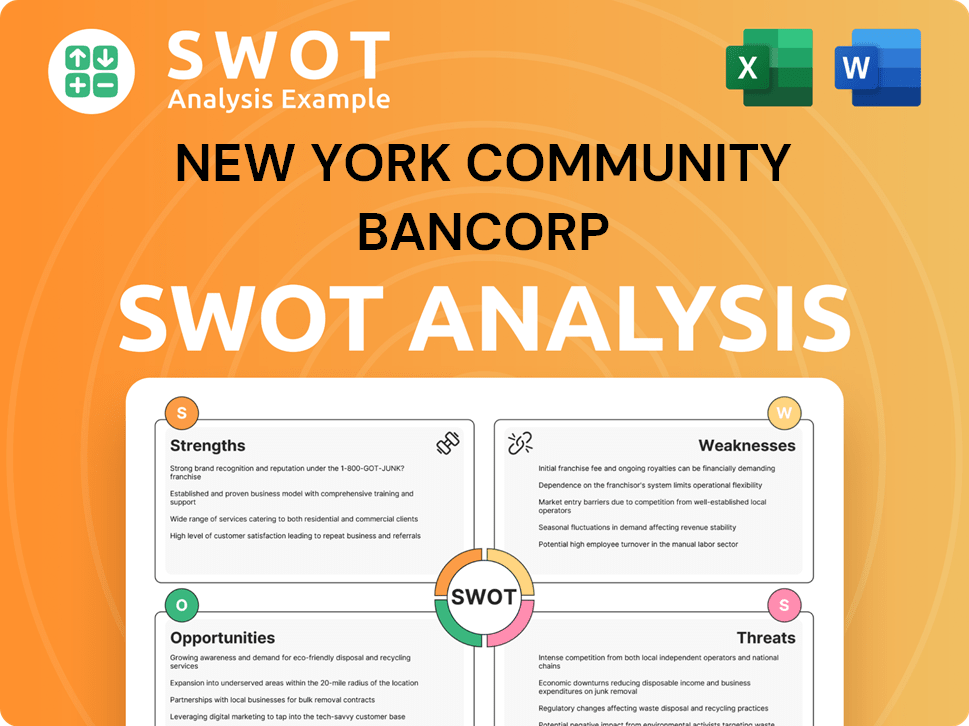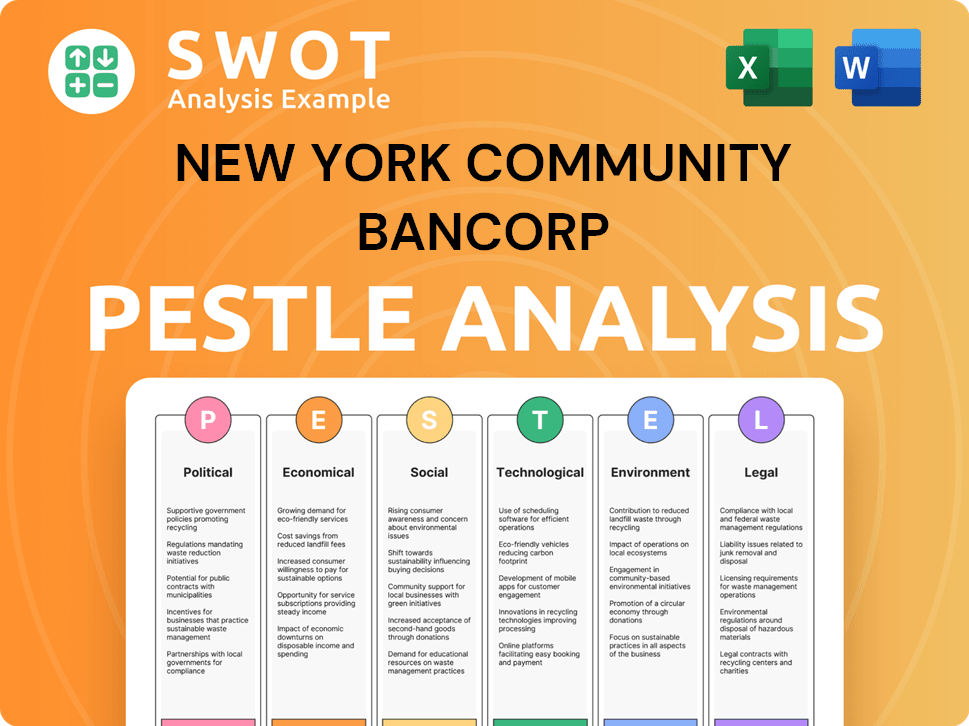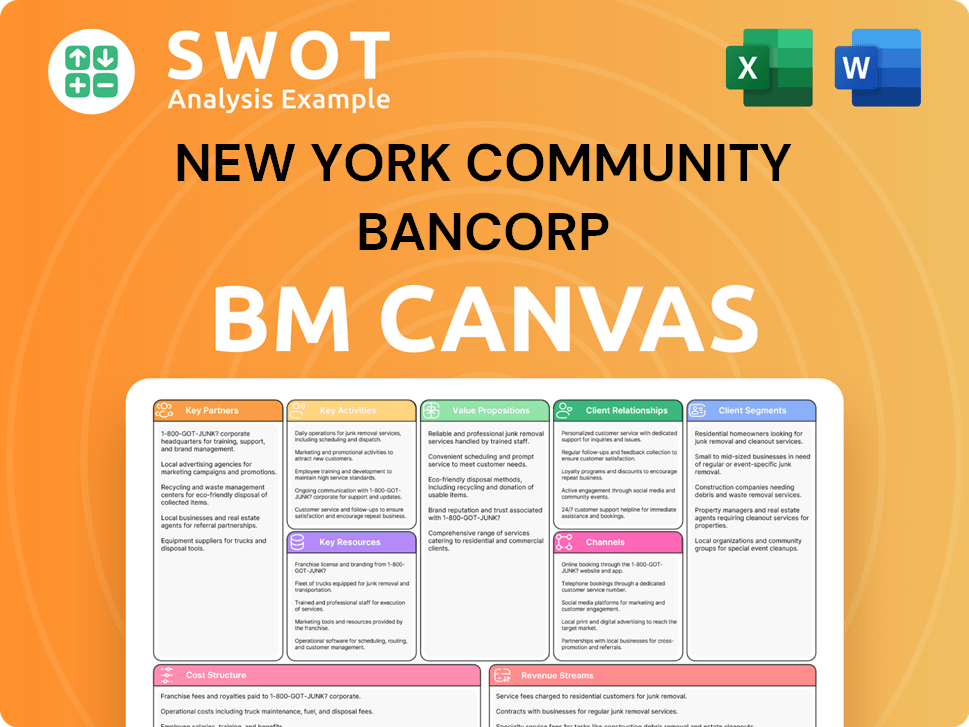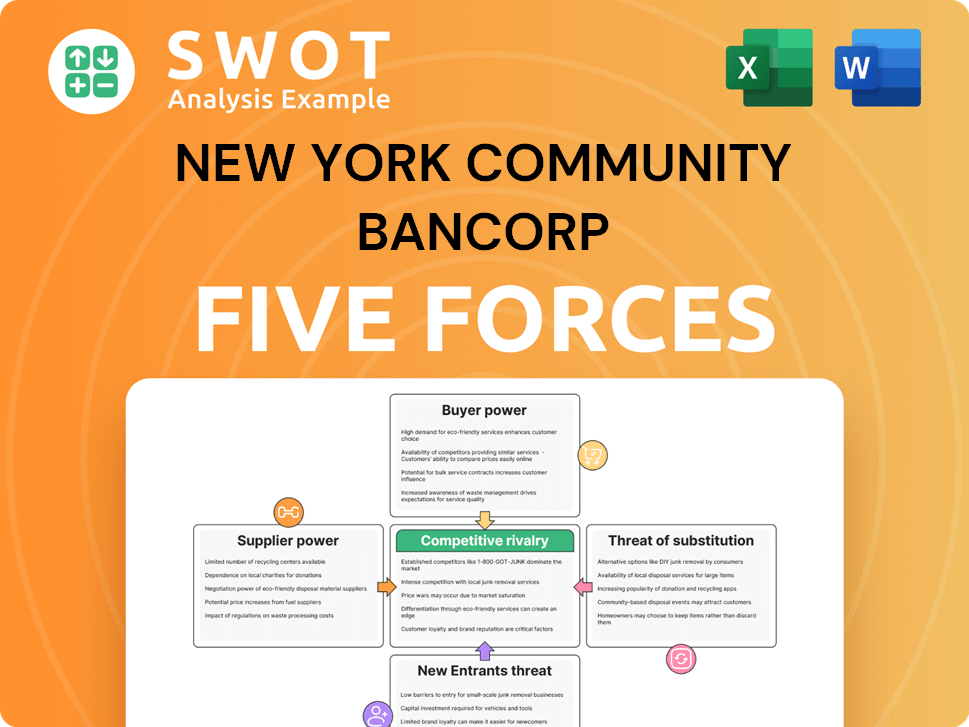New York Community Bancorp Bundle
Who Really Controls New York Community Bancorp?
Unraveling the ownership of New York Community Bancorp (NYCB) is crucial for understanding its future. The recent infusion of capital from institutional investors in March 2024 highlights how ownership changes can reshape a company, especially during challenging times. This analysis delves into the forces that shape NYCB’s strategic decisions and long-term prospects.

Founded in 1859, New York Community Bancorp, Inc. has evolved from a community bank to a significant financial player. New York Community Bancorp SWOT Analysis can provide additional insights. Understanding who owns NYCB, including its major shareholders and the composition of its board of directors, is key to evaluating its performance and potential. This exploration will examine NYCB ownership structure, its publicly traded status, and the influence of its investors on the company’s direction, answering questions such as "Who owns NYCB" and "How to find NYCB shareholder information."
Who Founded New York Community Bancorp?
The story of New York Community Bancorp (NYCB) begins with its roots as Queens County Savings Bank in 1859. Understanding the bank's early ownership structure is key to grasping its evolution into a publicly traded company. The initial framework was quite different from what we see in modern corporations, reflecting its origins as a mutual savings bank.
As a mutual savings bank, NYCB's early structure was designed to serve its depositors. This meant that the depositors were, in a sense, the 'owners,' with the bank operating for their benefit rather than for external shareholders' profit. This setup shaped the bank's governance and operational priorities.
Unlike today's publicly traded companies, there were no individual founders holding equity stakes or specific shareholding percentages. Instead, the bank was managed by a board of trustees. These trustees, often prominent community members, were responsible for managing the bank's assets and ensuring it fulfilled its mission of serving the community.
The bank was governed by a board of trustees, typically community leaders.
Early capital came primarily from deposits made by customers.
Depositors were the 'owners' in the sense that the bank operated for their benefit.
The focus was on financial prudence, community service, and providing a safe haven for savings.
There were no individual founders with equity stakes in the traditional sense.
Early capital was invested to generate returns, benefiting depositors through interest payments.
The early capital for the bank primarily came from deposits. These funds were then invested to generate returns, which benefited the depositors through interest payments and the overall stability of the bank. The founding team's vision centered on financial prudence, community service, and providing a safe place for local savings. This vision was reflected in the governance by its trustees, who acted for the collective benefit of its depositors. To learn more about the current status of the company, including who owns NYCB, you can read more about it here: 0.
The initial structure of New York Community Bancorp, as Queens County Savings Bank, was centered around its depositors.
- NYCB ownership was effectively held by its depositors in its early years.
- The bank was managed by a board of trustees, not individual shareholders.
- Early capital came from deposits, which were then invested to benefit depositors.
- The focus was on community service and financial stability.
New York Community Bancorp SWOT Analysis
- Complete SWOT Breakdown
- Fully Customizable
- Editable in Excel & Word
- Professional Formatting
- Investor-Ready Format

How Has New York Community Bancorp’s Ownership Changed Over Time?
The evolution of New York Community Bancorp (NYCB) from a mutual savings bank to a publicly traded entity fundamentally altered its ownership structure. The initial public offering (IPO) opened the door for external investors to acquire shares, marking a significant shift in who owns NYCB. Over time, NYCB's ownership has diversified, with a considerable portion held by institutional investors, including asset management firms, mutual funds, and hedge funds.
As of early 2025, major institutional holders of NYCB stock include Vanguard Group Inc., BlackRock Inc., and State Street Corp., reflecting their broad market index strategies and substantial capital deployment across publicly traded companies. This demonstrates the widespread institutional interest in NYCB and its position within the financial market. Understanding the NYCB ownership structure is crucial for investors and anyone interested in the company's strategic direction.
| Event | Date | Impact on Ownership |
|---|---|---|
| Initial Public Offering (IPO) | Various Dates | Transitioned from mutual to public ownership, allowing external investment. |
| Strategic Investment by Consortium | March 2024 | Liberty Strategic Capital, Hudson Bay Capital, and Reverence Capital Partners injected over $1 billion, significantly altering the shareholder landscape. |
| Institutional Investment | Ongoing | Vanguard, BlackRock, and State Street consistently hold significant stakes, reflecting broad market index strategies. |
A notable recent development impacting NYCB's ownership occurred in March 2024, when a consortium of investors, including Liberty Strategic Capital (led by former Treasury Secretary Steven Mnuchin), Hudson Bay Capital, and Reverence Capital Partners, injected over $1 billion into the company. This strategic investment involved the purchase of common stock and warrants, significantly altering the shareholder landscape and providing a crucial capital infusion. As part of this transaction, Liberty Strategic Capital became a significant shareholder, with Steven Mnuchin also joining the board of directors. This influx of capital and change in major stakeholders directly impacted company strategy, focusing on strengthening the balance sheet and addressing concerns about asset quality. For further insights into the company's strategic direction, consider reading about the Growth Strategy of New York Community Bancorp.
NYCB's ownership has evolved from a mutual savings bank to a publicly traded company with diverse shareholders.
- Institutional investors, such as Vanguard, BlackRock, and State Street, hold significant stakes in NYCB.
- A strategic investment in March 2024 by a consortium led by Liberty Strategic Capital significantly altered the shareholder structure.
- Understanding the ownership structure is key for those interested in NYCB stock and its strategic direction.
- Knowing who owns NYCB provides insights into the company's stability and future prospects.
New York Community Bancorp PESTLE Analysis
- Covers All 6 PESTLE Categories
- No Research Needed – Save Hours of Work
- Built by Experts, Trusted by Consultants
- Instant Download, Ready to Use
- 100% Editable, Fully Customizable

Who Sits on New York Community Bancorp’s Board?
The current board of directors of New York Community Bancorp (NYCB) includes a blend of long-tenured members and new appointees. This shift is particularly noticeable after the capital infusion in March 2024. As of early 2025, the board features individuals representing major shareholders alongside independent directors. A key development was the appointment of Steven Mnuchin, representing Liberty Strategic Capital, to the board as Vice Chairman. This appointment signals the direct influence of the new strategic investors on governance and decision-making. Joseph Otting also joined the board as CEO and President, further solidifying the new leadership's presence. This restructuring reflects adjustments in Growth Strategy of New York Community Bancorp.
The board's composition is crucial for understanding who controls New York Community Bancorp. The presence of directors representing significant shareholders, such as Liberty Strategic Capital, provides these investors with a direct voice and influence over company strategy and oversight. This setup is typical for publicly traded companies, where shareholder representation on the board is a standard practice. Understanding the board's makeup helps in assessing the alignment of interests between management and the major NYCB shareholders.
| Board Member | Title | Affiliation |
|---|---|---|
| Steven Mnuchin | Vice Chairman | Liberty Strategic Capital |
| Joseph Otting | CEO and President | New York Community Bancorp |
| Alessandro P. DiNello | Director | Independent |
NYCB generally operates under a one-share-one-vote structure for its common stock. This means voting power is directly proportional to the number of shares owned. The March 2024 investment, which included the purchase of common stock, directly translated into increased voting power for the consortium of NYCB investors. While there are no publicly disclosed special voting rights, the collective voting power of major institutional investors and the recently introduced strategic investors is substantial. Knowing who owns NYCB is critical for understanding the company's strategic direction.
The voting structure at New York Community Bancorp is straightforward, with voting rights tied directly to share ownership. This structure means that the more NYCB stock an investor holds, the greater their influence on company decisions.
- Major shareholders have significant influence.
- The board of directors reflects shareholder interests.
- Understanding NYCB ownership is key to assessing the company's strategic direction.
- The stock's performance is directly impacted by the decisions of the board.
New York Community Bancorp Business Model Canvas
- Complete 9-Block Business Model Canvas
- Effortlessly Communicate Your Business Strategy
- Investor-Ready BMC Format
- 100% Editable and Customizable
- Clear and Structured Layout

What Recent Changes Have Shaped New York Community Bancorp’s Ownership Landscape?
Over the past few years, the ownership landscape of New York Community Bancorp (NYCB) has seen significant shifts, most notably the substantial capital raise in March 2024. This strategic move, involving over $1 billion from a consortium led by Liberty Strategic Capital, was a critical step to bolster the bank's capital and address market concerns. This investment resulted in a dilution of existing NYCB shareholders but also brought in new, influential stakeholders with a vested interest in the company's turnaround. This event is a key factor in understanding Who owns NYCB now.
Industry trends in bank ownership have highlighted the importance of capital adequacy and risk management, particularly in light of recent regional banking stresses. This has led to increased scrutiny of institutional ownership and the stability of a bank's shareholder base. For NYCB, the March 2024 investment exemplifies a trend where strategic investors with deep financial sector expertise step in to stabilize and guide financial institutions during challenging periods. Future actions will likely be influenced by the new leadership and board composition. The company's public statements and analyst coverage following the capital raise indicate a renewed focus on improving financial performance and asset quality, potentially attracting further institutional investment or shifts in the NYCB ownership mix as the company executes its new strategy. For insights into the company's marketing approach, explore the Marketing Strategy of New York Community Bancorp.
The March 2024 capital raise was a pivotal event, injecting over $1 billion into the bank. This influx of capital was led by Liberty Strategic Capital, signaling confidence in the bank's future. The investment diluted existing shareholders but brought in new, strategic investors.
There's a growing focus on capital adequacy and risk management within the banking sector. Strategic investors are increasingly stepping in to stabilize and guide financial institutions. Future ownership shifts will likely be influenced by the bank's performance and strategic execution.
New York Community Bancorp Porter's Five Forces Analysis
- Covers All 5 Competitive Forces in Detail
- Structured for Consultants, Students, and Founders
- 100% Editable in Microsoft Word & Excel
- Instant Digital Download – Use Immediately
- Compatible with Mac & PC – Fully Unlocked

Related Blogs
- What are Mission Vision & Core Values of New York Community Bancorp Company?
- What is Competitive Landscape of New York Community Bancorp Company?
- What is Growth Strategy and Future Prospects of New York Community Bancorp Company?
- How Does New York Community Bancorp Company Work?
- What is Sales and Marketing Strategy of New York Community Bancorp Company?
- What is Brief History of New York Community Bancorp Company?
- What is Customer Demographics and Target Market of New York Community Bancorp Company?
Disclaimer
All information, articles, and product details provided on this website are for general informational and educational purposes only. We do not claim any ownership over, nor do we intend to infringe upon, any trademarks, copyrights, logos, brand names, or other intellectual property mentioned or depicted on this site. Such intellectual property remains the property of its respective owners, and any references here are made solely for identification or informational purposes, without implying any affiliation, endorsement, or partnership.
We make no representations or warranties, express or implied, regarding the accuracy, completeness, or suitability of any content or products presented. Nothing on this website should be construed as legal, tax, investment, financial, medical, or other professional advice. In addition, no part of this site—including articles or product references—constitutes a solicitation, recommendation, endorsement, advertisement, or offer to buy or sell any securities, franchises, or other financial instruments, particularly in jurisdictions where such activity would be unlawful.
All content is of a general nature and may not address the specific circumstances of any individual or entity. It is not a substitute for professional advice or services. Any actions you take based on the information provided here are strictly at your own risk. You accept full responsibility for any decisions or outcomes arising from your use of this website and agree to release us from any liability in connection with your use of, or reliance upon, the content or products found herein.